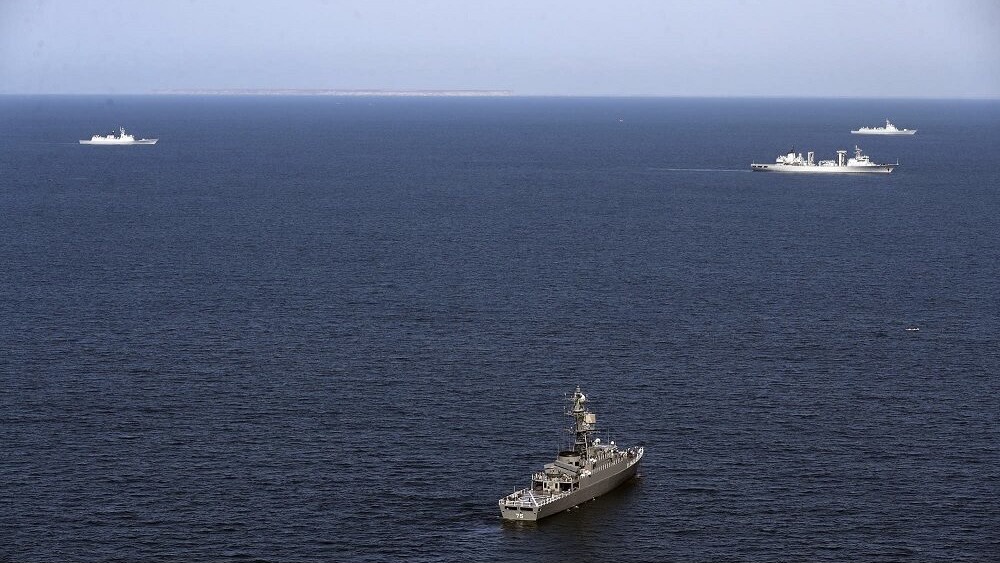Iran, China, and Russia carried out a naval exercise in the Gulf of Oman from March 12-15. The drill, named the Marine Security Belt 2024, encompassed an area of 17,000 square kilometers (6,600 square miles). Azerbaijan, Kazakhstan, Oman, Pakistan, and South Africa were official observers of the action.
The naval exercise had the goal of “strengthening maritime cooperation and safeguarding peace and stability,” as stated by the Chinese Defense Ministry. Iran’s Admiral Mostafa Tajaddini stated that the three nations’ operation was also meant to confront “piracy and terrorism, support humanitarian activities and the exchange of information in the field of rescue.”
The Marine Security Belt 2024 involved more than 20 ships. China sent guided-missile destroyer Urumqi, guided-missile frigate Linyi and comprehensive supply ship Dongpinghu, Russia sent the cruiser Varyag from its Pacific Fleet, while Iran contributed a range of vessels, including warships Dena and Abu-Mahdi, as well as naval helicopters, speedboats and submersibles.
The exercise was not unprecedented, as the three countries had carried out three other similar exercises since 2019. Though, it was a display of increased cooperation between the three countries.
The location of the exercise is noteworthy. The Gulf of Oman is in the northern part of the Indian Ocean. It leads into the Strait of Hormuz, right off the coast of Iran. The Strait of Hormuz connects the Gulf of Oman to the Persian Gulf. At its narrowest point, it is only 21 miles wide, of which only 6 miles are navigable. As much as 21% of the world’s oil is shipped through the strait of Hormuz. For this reason, the Strait is of strategic geopolitical importance. Any disruptions in shipping through this strait would cause an immediate spike in the price of oil, potentially destabilizing the world’s economy.
Farther west in the Indian Ocean is the Gulf of Aden, leading to the Strait of Bab-el-Mandeb, on to the Red Sea. It is in this area that the United States is leading a coalition of forces in intense naval operations since December 2023.
Yemen’s blockade challenges strength of US empire
Israel’s genocide of Gaza has had an enormous impact on the peoples of the entire world, and especially in West Asia. In the region, people have demanded action from their governments in support of Gaza. The most concrete actions did not come from oil rich Gulf monarchies, which limited their actions to words, making statements and declarations. They came from Yemen, a country emerging from an eight year occupation by a Saudi-led coalition. Yemen suffered immensely through the occupation, with widespread extreme poverty, starvation and disease.
It was only two years ago, on March 30, 2022, that Saudi Arabia ended its occupation. As a result of the brutal occupation, Yemen is still struggling with a severe economic crisis, with an estimated 50% of its population living below the poverty line. The force leading the fight against the Saudi invasion was Ansar Allah, which leads the Yemeni government today, referred to in Western media as the Houthis.
In November 2023, Yemen started showing solidarity with Palestinians suffering from the genocide by targeting all ships supplying Israel sailing off its shores. Whether Israeli-flagged or not, Ansar Allah’s pledge to disrupt Israeli supplies has been a success. Despite overwhelming naval superiority, the US, UK and their allies have been unsuccessful at making the passage of Israeli supply ships safe.
The Strait of Bab-el-Mandeb is only 20 miles wide. This largely neutralizes the vast advantage that the US navy enjoys in the region. The March 14 reports that the Yemeni forces have acquired supersonic missiles further exacerbates the US challenge in helping Israel resupply its military for its nearly six month long bombing of Gaza.
In years past, the US dominance over the Indian Ocean, specifically in the Persian Gulf, Gulf of Oman and the Red Sea went unchallenged. Geography has enabled countries challenging US hegemony in the region, like Iran and Yemen, to challenge that naval dominance, not by matching the US naval might, which would require resources they lacked. Instead, they have had to acquire enough firepower to enable them to engage in asymmetric warfare should an open war break out. Rockets, missiles and speedboats have been somewhat of an equalizer in narrow waterways where the technological advantages of the US are minimized.
The US does not own the seas
Traditional naval exercises of the kind Iran, China and Russia just carried out, however, are another challenge to US naval dominance. Here again, the three countries combined may not be able to match the US naval presence in the region. But the message that this naval drill sends to the United States is that it does not own the waters of the region.
March 15 marked the completion of Marine Security Belt 2024. Iran announced the operation a success and that the goals of the exercise had been met.
Mazda Majidi is a long-time social justice and anti-war activist and an activist with the ANSWER Coalition. He has written extensively on US intervention in the Middle East and beyond.





